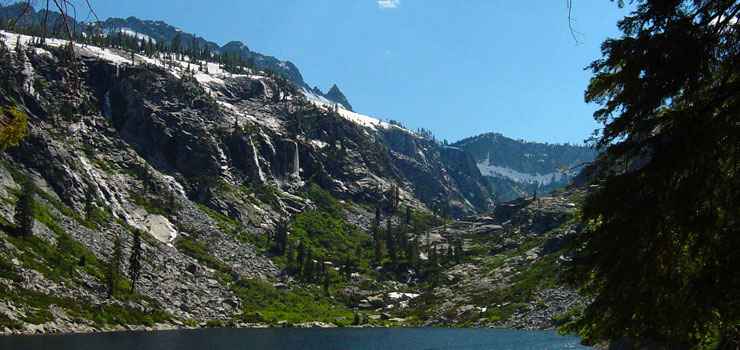Trinity Alps Wilderness

A view of Emerald Lake in the Trinity Alps Wilderness
Trinity Alps Wilderness is a 525,627-acre property jointly managed by Klamath, Shasta-Trinity and Six-Rivers National Forests. About 4,623 acres of the wilderness is managed by the Bureau of Land Management.
Trinity Alps Wilderness is located in the Scott and Salmon Mountains, subranges of the Coastal Mountains in the Klamath Mountains area. This is an area of sharp, high granitic peaks surrounded by mostly coniferous forests. What's different in the Trinity Alps area is the predominance of Sierran trees and plants only 60 miles from the Pacific Ocean.
The forests are mostly a mix of western white pine, foxtail pine, whitebark pine, lodgepole pine, ponderosa pine and red and white firs. Among the larger mammals are blacktailed deer, mountain lion, bobcat, black bear, coyote and wolverine. The high country is filled with glacial cirques that hold many small lakes that have been stocked with trout. Tributaries of the lower Trinity River see steelhead runs in summer and winter, chinook salmon runs in spring.
The Wild and Scenic Trinity River is in the southern portion of the wilderness, the Wild and Scenic Salmon River in the north.
Interspersed among the stands of trees are numerous large meadows looking up to barren rock cliffs and stark peaks up to 9,000 feet in elevation. As close as this is to the Pacific Coast, some winters have seen up to 12 feet of snow fall in the high country.
There were about 520 miles of trails in the last inventory but with maintenance being what it is, maybe 20% of them are still marked and used with any frequency. The Pacific Crest Trail does make about 17 miles of highly used trail through the Scott Mountains in the northeast portion of the wilderness. The as-yet-unfinished Bigfoot Trail accounts for another 35 miles of trail. Along the paved road north from Junction City is the Canyon Creek trailhead, giving access to probably the most popular trail in the wilderness. In some areas there are historic mining structures and other relics still standing.